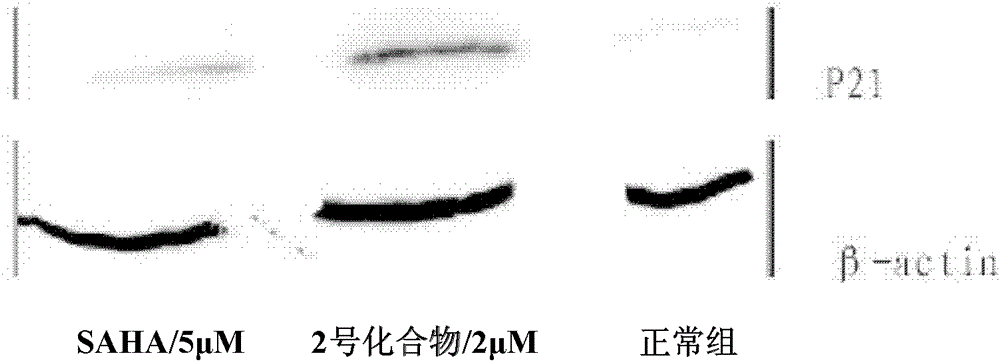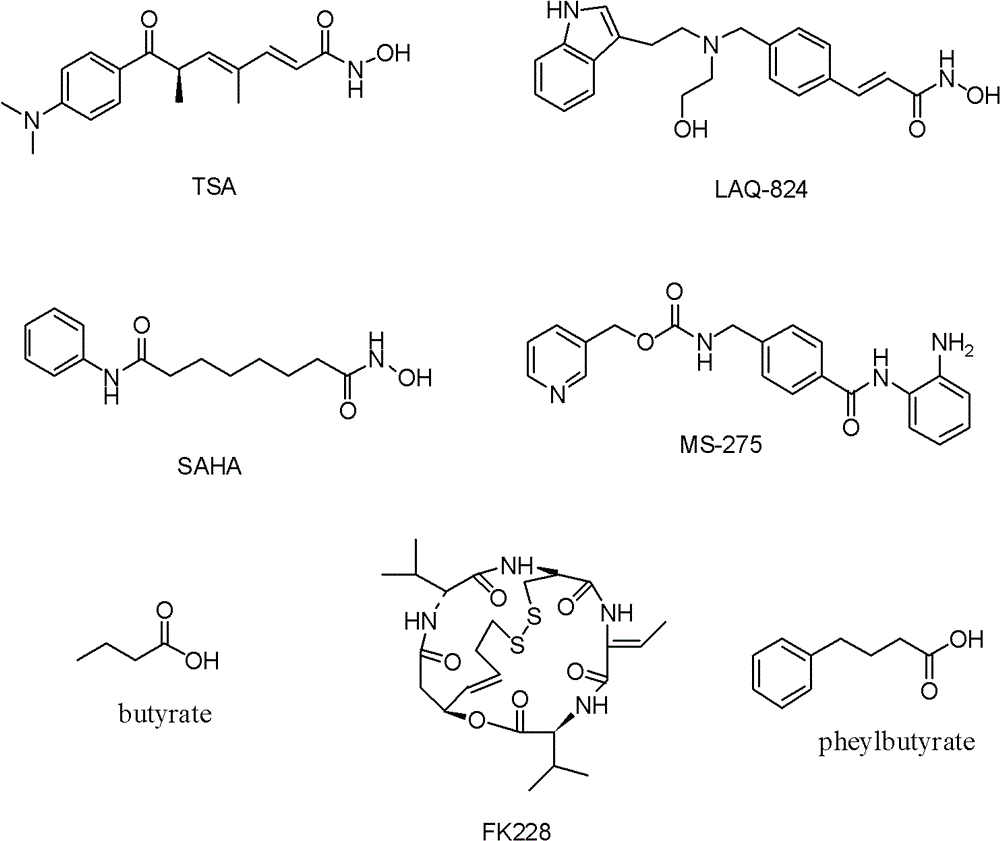A kind of hydroxamic acid compound and its preparation method and application
A compound and hydroxime technology, applied in the field of hydroxamic acid compounds, can solve problems such as abnormal gene inhibition
- Summary
- Abstract
- Description
- Claims
- Application Information
AI Technical Summary
Problems solved by technology
Method used
Image
Examples
Embodiment 1
[0075] The preparation of embodiment 12-[4-benzamide cyclohexylidene] methyl acetate:
[0076] Step 1, utilize the witting reaction principle to prepare 2-[4-(N-tert-butoxycarbonylamino) cyclohexylidene] methyl acetate:
[0077] In the there-necked flask with drying tube, reflux condenser and thermometer, add 2.13g (10mmol) 4-N-tert-butoxycarbonylaminocyclohexanone, 2.73g (15mmol) trimethyl phosphonoacetate and 100ml tetrahydrofuran, After stirring and dissolving, add 0.42g (17.5mmol) lithium hydroxide and 15g4A molecular sieve, stir at room temperature for a few minutes, then raise the temperature and reflux for 10 hours. The reaction mixture was filtered, and the filtrate was concentrated under reduced pressure to obtain a white solid product with a yield of 95%.
[0078] Step 2, prepare 2-(4-aminocyclohexylene) methyl acetate:
[0079] In a single-necked bottle with a drying tube, add 2.69g (10mmol) methyl 2-[4-(N-tert-butoxycarbonylamino)cyclohexylene]acetate, 50ml dichl...
Embodiment 2
[0082] The preparation of embodiment 22-[4-(2-quinoline carboxamide) cyclohexylidene] methyl acetate
[0083] Step 1 and Step 2 refer to Example 1.
[0084] Step 3: Add 5.19g (30mmol) of quinoline 2-carboxylic acid and 200ml of tetrahydrofuran into a single-necked bottle with a drying tube, stir and dissolve, then add 8.92g of HBTU (23.54mmol) and 60ml of N,N-dimethylformamide, Stir at room temperature for half an hour, then add 3.62 g (21.4 mmol) of methyl 2-(4-aminocyclohexylene) acetate, adjust the pH to ≥ 8 with diisopropylethylamine, and continue stirring at room temperature for 8 hours. The reaction mixture was concentrated in vacuo, 100 ml of water was added to the residue, and a milky white solid was precipitated by shaking and shaking. The milky white solid was dissolved in ethyl acetate, washed twice with water, 5% potassium carbonate, 2% hydrochloric acid, and saturated brine, and dried over anhydrous sodium sulfate. After suction filtration, the solvent was evapo...
Embodiment 3
[0085] Preparation of Example 32-[4-(8-quinolinesulfonamide)cyclohexylene]methyl acetate
[0086] Step 1 and Step 2 refer to Example 1.
[0087] Step 3, in the three-necked flask, add 3.38g (20mmol) 2-(4-aminocyclohexylene) methyl acetate and 6.06g (60mmol) triethylamine, stir and dissolve with 80ml dichloromethane, and cool in an ice bath to At 0° C., a dichloromethane solution of 6.83 g (30 mmol) quinoline 8-sulfonyl chloride was added dropwise. During the dropwise addition, the temperature was kept at 0-5°C, and then gradually raised to room temperature and stirred for three hours. The reaction mixture was concentrated in vacuo, washed successively with saturated sodium bicarbonate solution and saturated brine twice, and dried over anhydrous sodium sulfate. After suction filtration, the solvent was evaporated under reduced pressure, and the pure product was obtained by column chromatography with a yield of 65%.
PUM
 Login to View More
Login to View More Abstract
Description
Claims
Application Information
 Login to View More
Login to View More - R&D Engineer
- R&D Manager
- IP Professional
- Industry Leading Data Capabilities
- Powerful AI technology
- Patent DNA Extraction
Browse by: Latest US Patents, China's latest patents, Technical Efficacy Thesaurus, Application Domain, Technology Topic, Popular Technical Reports.
© 2024 PatSnap. All rights reserved.Legal|Privacy policy|Modern Slavery Act Transparency Statement|Sitemap|About US| Contact US: help@patsnap.com










